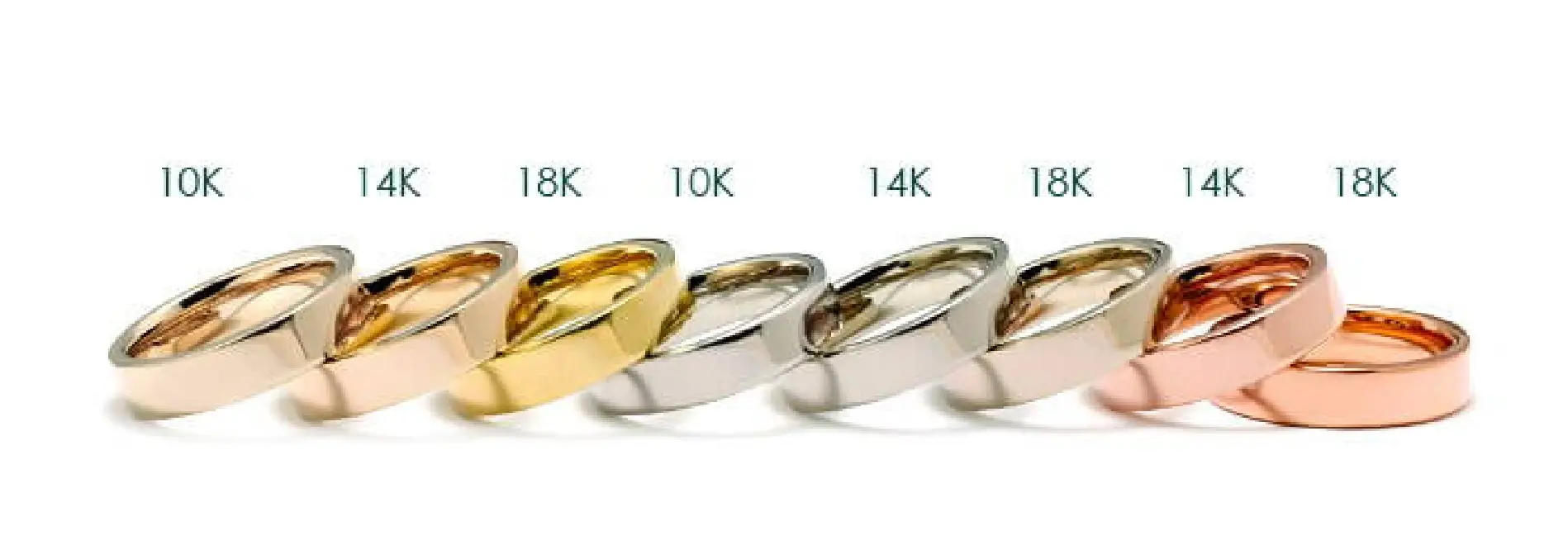Pure gold is slightly reddish yellow in colour, but coloured gold in various other colours can be produced by alloying gold with other elements.
Coloured golds can be classified in three groups
1. Alloys with silver and copper in various proportions, producing white, yellow, green and red golds. These are typically malleable alloys.
2. Intermetallic compounds, producing blue and purple golds, as well as other colours. These are typically brittle, but can be used as gems and inlays.
3. Surface treatments, such as oxide layers.
Pure 100% (in practice, 99.9% or better) gold is 24 karat by definition, so all coloured golds are less pure than this, commonly 18K (75%), 14K (58.5%), 10K (41.6%), or 9K (37.5%).
- Alloys
- White Gold
White gold is an alloy of gold and at least one white metal (usually nickel, silver, or palladium). Like yellow gold, the purity of white gold is given in karats.
A common white gold formulation consists of 90% wt. gold and 10% wt. nickel. Copper can be added to increase malleability.
The alloys used in the jewelry industry are gold–palladium–silver and gold–nickel–copper–zinc. Palladium and nickel act as primary bleaching agents for gold; zinc acts as a secondary bleaching agent to attenuate the color of copper.
- Yellow Gold
Examples of the common alloys for 18K yellow gold include:
18K yellow gold: 75% gold, 12.5% copper, 12.5% silver
18K yellow (darker) gold: 75% gold, 15% copper, 10% silver
- Rose, Red and Pink Gold
Rose gold is a gold–copper alloy widely used for specialized jewelry and is becoming more popular in the 21st century, and is commonly used for wedding rings, bracelets, and other jewelry.
Although the names are often used interchangeably, the difference between red, rose, and pink gold is the copper content: the higher the copper content, the stronger the red coloration. Pink gold uses the least copper, followed by rose gold, with red gold having the highest copper content.
Examples includes:
- 18K red gold: 75% gold, 25% copper
- 18K rose gold: 75% gold, 22.25% copper, 2.75% silver
- 18K pink gold: 75% gold, 20% copper, 5% silver
- 12K red gold: 50% gold and 50% copper
Up to 15% zinc can be added to copper-rich alloys to change their color to reddish yellow or dark yellow.
14K red gold, often found in the Middle East, contains 41.67% copper. The highest-karat version of rose gold, also known as crown gold, is 22 karat.
- Spangold
Some gold-copper–aluminium alloys form a fine surface texture at heat treatment, yielding an interesting spangling effect.
The alloy of 76% gold, 19% copper, and 5% aluminium yields a yellow color; the alloy of 76% gold, 18% copper and 6% aluminium is pink.
- Green Gold
Green gold is a naturally occurring alloy of silver and gold. It actually appears as greenish-yellow rather than green.
Cadmium can also be added to gold alloys to create a green color, but there are health concerns regarding its use, as cadmium is highly toxic. The alloy of 75% gold, 15% silver, 6% copper, and 4% cadmium yields a dark-green alloy.
Grey gold alloys are usually made from gold and palladium. A cheaper alternative which does not use palladium is made by adding silver, manganese, and copper to the gold in specific ratios.
- Intermetallic
- Purple Gold
Purple gold (also called amethyst gold and violet gold) is an alloy of gold and aluminium rich in gold–aluminium intermetallic (AuAl2). Gold content in AuAl2 is around 79% and can therefore be referred to as 18 karat gold. Purple gold is more brittle than other gold alloys.
- Blue Gold
Blue gold is an alloy of gold and either gallium or indium. Gold–indium contains 46% gold (about 11 karat) and 54% indium, forming an intermetallic compound.
Surface Treatments
- Black Gold
Black gold is a type of gold used in jewelry. Black-colored gold can be produced by various methods:
• Patination by applying sulfur- and oxygen-containing compounds.
• Plasma-assisted chemical vapor deposition process involving amorphous carbon
• Controlled oxidation of gold containing chromium or cobalt (e.g. 75% gold, 25% cobalt).
• A range of colors from brown to black can be achieved on copper-rich alloys by treatment with potassium sulfide.
Cobalt-containing alloys, e.g. 75% gold with 25% cobalt, form a black oxide layer with heat treatment at 700–950 °C. Copper, iron and titanium can be also used for such effect. Gold–cobalt–chromium alloy (75% gold, 15% cobalt, 10% chromium) yields a surface oxide that is olive-tinted because of the chromium oxide content.
- Blue Gold
Oxide layers can also be used to obtain blue gold from an alloy of 75% gold, 24.4% iron, and 0.6% nickel; the layer forms on heat treatment in air between 450–600 °C.
A rich sapphire blue colored gold of 20–23K can also be obtained by alloying with ruthenium, rhodium and three other elements and heat-treating at 1800 °C, to form the 3–6 micrometers thick colored surface oxide layer.







